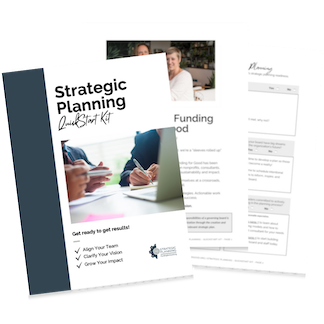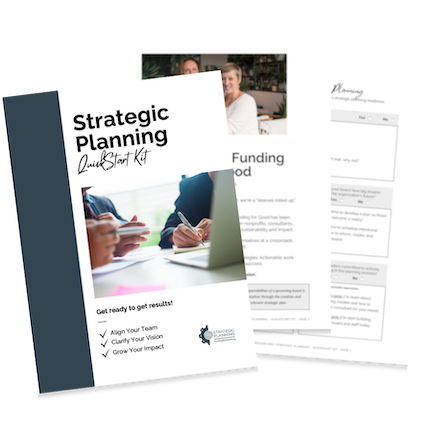Founder’s syndrome is one of the thorniest—and most common—challenges in the nonprofit sector.
If you’re in the nonprofit world, chances are you’ve been affected by founder’s syndrome, even if you didn’t know the name for it. From decision-making to making an impact, founder’s syndrome can wreak havoc within organizations.
Luckily, there are ways to address this ailment. In this article, we’ll take a closer look at founder’s syndrome, its most common symptoms, and some proven treatments (including how strategic planning can help).
What Is Founder’s Syndrome?
Founder’s syndrome has a few key elements: personality, power, process, and progress.
Founder’s syndrome has been defined as “a disease in nonprofits that has its genesis in the inspiration and personality—or personalities—that created the organization.”
Founder’s syndrome happens when charismatic leaders are unable to let go or grow. This person or group of people has often founded the organization or saved it from the brink. Yet over time, they are unable to evolve to meet the changing needs of their organization—leading to conflicts, power struggles, and internal dysfunction.
Does this sound familiar?
Contrary to popular belief, founder’s syndrome doesn’t only afflict a single founder. The condition can manifest itself in an individual or group of charter board members, a particularly dominant board officer, a CEO, or even a long-time staff member. In many cases, the afflicted leader or leaders does not realize what is happening.
What Causes Founder’s Syndrome?
Founder’s syndrome can develop when leaders are thrust into a position where the life of a nonprofit is directly linked with their ability to meet critical needs, overcome major obstacles, or generate the interest and resources needed to keep the doors open.
Onset usually occurs at the beginning stages of organizational development or during a crisis period. While the “founder” is responsible for keeping the organization alive during that period, conditions eventually change.
Over time, the organization stabilizes and grows. Experienced staff members are hired, boards transition, and funding becomes more sustainable. The “founder” has led the organization to success. This is an incredible accomplishment!
The challenge comes when the “founder” is unable to change with the organization to ensure their participation remains relevant and timely.
Common Symptoms of Founder’s Syndrome
As with any ailment, the first step toward recovery is to recognize the symptoms and confirm the diagnosis.
Common habits in a leader or leadership group afflicted with founder’s syndrome include:
- Micromanaging day-to-day operations even though those tasks have been delegated to other qualified staff or committees.
- Guarding organization resources, thus limiting the effectiveness of other team members.
- Insisting on holding donor relationships and not allowing other development or program leaders to meet with donors alone.
- Trying to oversee projects even when someone else is clearly more suited for the job.
- Committing the organization to new initiatives or partnerships without consulting staff or board leadership.
- Struggling to adapt to changes within the organization (mission, programs, fundraising, new staff, etc.).
- Preferring to be the first point of contact for all issues—even if other qualified staff could or should be.
- Representing their opinion to stakeholders as the consensus opinion of the organization.
- Encouraging political alliances, gamesmanship, and backroom deals instead of seeking consensus through established and transparent decision-making channels.
- Showing disrespect for the time-honored structure of nonprofit roles, responsibilities, and by-laws.
While most of those symptoms appear to be negative, it is important to acknowledge the intent and integrity that many founders possess.
For example, while many board members may just be “warming a seat,” the founder is busy burning the midnight oil. Founders often invest a better portion of their time, talents, and treasures in the organization they helped create. This forges an emotional connection that is extremely difficult to break.
How to Treat Founder’s Syndrome
Founders have so many amazing qualities that it would be cruel to them and possibly detrimental to the organization to simply “push them out” and cut ties. These are passionate individuals who tend to be loved and respected by the community. They have incredible wisdom and experience.
Rather than jumping to remove a founder from the organization, nonprofits should start by opening a conversation. The goal is to find ways that the leader or leaders can continue to benefit the organization as it evolves.
Here are 10 key steps you can take.
1. Clarify roles and responsibilities for the board and staff. Our Leadership Report Template and Board of Directors Job Description Template can give you a head start.
2. Establish checks and balances so one person doesn’t hold veto power over the entire board and staff. No single person should have veto authority or lead on the appearance of having so.
3. Modify operating systems to ensure that everyone understands and adheres to the chain of command and that the founder is not at the top of that chain. For example, lead staff such as the Executive Director or Development Director should never be told that their “direct supervisor” is the founder. Lead staff should report regularly to a designated committee (executive committee, personnel committee, oversight committee, etc.). That committee should provide resources, offer consensus when needed, outline job descriptions, and complete regular evaluations of the CEO or Executive Director’s performance. Founders might be the source of conflict since they tend to overstep their roles and become heavily involved in the day-to-day operating processes. If the founder is also the head of the personnel committee or human resources functions, staff do not have a viable way to express their grievances or seek positive resolutions. Assessing and updating internal systems and structures can be done as part of a comprehensive strategic planning process.
4. Update bylaws and other policies to ensure that board term limits are established and respected, and that there is true oversight for the Executive Director, CEO, and other senior staff.
5. Build a diverse board of directors who understand that their fiduciary duty of loyalty is to the organization as a whole and not simply to the founder(s).
6. Charge the board’s executive committee with monitoring and addressing issues and symptoms that stem from founder’s syndrome.
7. Identify the passion and skill set of the founder(s) and establish strategic ways to engage the founder(s) in organizational development so they can adapt and become part of the change.
8. Acknowledge the contributions of the founder(s) and respect their input even if it isn’t always in the best interest of the organization to adhere to those suggestions.
9. Understand that the founder(s) has a strong emotional bond with the organization and considers it their “baby.”
10. Help the founder recognize that while they played a critical role in birthing the “baby,” the organization (much like a child) must learn to function independently, and many different people must play a role in that growth and development.
Finding Common Ground
At the end of the day, both those who suffer from founder’s syndrome and those who suffer because of a founder should be able to reach common ground if they have the best interest of the organization at heart.
Everyone wants the organization to grow and become self-sustaining, right?
Perhaps it’s time to recognize that co-parenting (with board and staff support) is the best way to make that happen! While challenging, this process can be incredibly rewarding.
Just as many couples seek a professional marriage counselor to facilitate an open dialogue and help “save” a marriage, organizations can benefit from the assistance of professionals who are equipped to do the same for your mission. If you’d like to learn more about how strategic planning or board development can help your organization navigate founder’s syndrome, book a free discovery call with our team.



